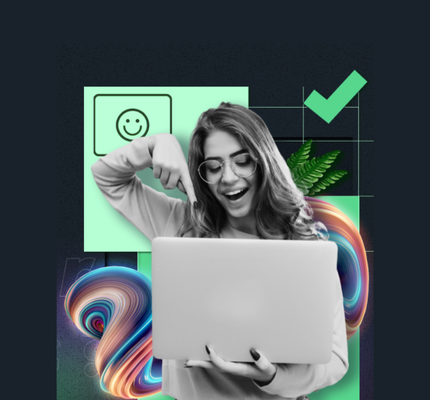Blog
8 ways to create a premium B2B online ecommerce experience

As more and more B2B buyers move online, it’s critical for businesses to create a premium ecommerce experience. B2B customers expect:
- A user-friendly interface
- Fast and secure transactions
- Easy access to product information.
By focusing on these key elements, businesses can create a premium ecommerce experience for their B2B customers. Here are some strategies to achieve this:
1. Streamline the Online Experience
B2B customers are busy and want to get in and out of the purchasing process quickly. To create a premium ecommerce experience, it’s important to streamline the online experience.
This means creating an intuitive and user-friendly interface that allows customers to easily navigate the site, find products, and complete transactions.
Keep in mind that B2B ecommerce sites can host 1,000s of products, with different configurations of each, so it’s especially important that your search and navigation tools are powerful and intuitive to use.
2. Use the right platform
Not all ecommerce platforms are designed to support a B2B business. Adobe Commerce offers advanced B2B support and functionality, including:
- Customer-specific pricing
- Custom catalogues
- Complex order workflows
- Full scalability and customisation
- Integrations with CRMs and ERPs
- Support for bulk order processing
Discover the full list of features and functions of Adobe Commerce B2B here.
3. Optimise for Mobile Devices
More and more B2B buyers are using mobile devices to make purchases on the go.
To create a premium ecommerce experience, businesses must have:
- A responsive website design that adjusts to different screen sizes
- A fast page load time
- The same site functionality as is available on desktop
With new technology emerging like the super fast front end theme Hyva, which is now Fluid Commerce’s choice over the standard Luma Adobe Commerce/Magento theme, B2B sites are now disrupting the old-skool mentality of “Slow B2B websites”. Read more on Hyva here.
4. Provide Accurate Product Information
B2B customers want to make informed purchasing decisions, and providing accurate and detailed product information is essential.
This includes providing:
- Product descriptions
- Specifications
- Images and videos
- Customer reviews and ratings
By providing accurate product information, businesses can make it easier for customers to make informed purchasing decisions. This will boost conversion rates, reduce returns, and build trust with their B2B customers.
5. Offer Personalised Product Recommendations
Personalisation is key to creating a premium ecommerce experience. Businesses can use data such as purchase history, search history, and customer demographics to offer personalised product recommendations.
This can help B2B customers find the products they need quickly and easily, and can also increase the chances of cross-selling and up-selling.
To showcase product recommendations, merchants can use areas like:
- Basket
- Add to basket lightboxes
- Product pages
- Category pages
- Blog/news articles
- Confirmation pages
Many product recommendations provider new utilise the powers of AI technology which look at past visits, pages visited and overall browser engagement to push the most obvious products to the customer.
6. Provide Fast and Secure Transactions
B2B customers want a fast and secure purchasing experience. This means ensuring that the site is secure and that all transactions are processed quickly and accurately.
It’s important to offer multiple payment options and to make sure that the purchasing process is as streamlined as possible. By providing fast and secure transactions, businesses can increase customer trust and loyalty.
7. Offer Excellent Customer Support
Excellent customer support is essential. Businesses must provide multiple channels for support, such as email, chat, or phone, and respond to inquiries in a timely manner.
It’s also important to provide knowledgeable and friendly support staff who can answer customer questions and resolve issues quickly. By offering excellent customer support, businesses can increase customer satisfaction and loyalty.
There are many great chatbots now that have really upped their game by adding more AI-based technology into the logic.
If your chat system is integrated well with your ecommerce platform, that it is pretty standard practice for your chatbot to answer questions like “Where is my order” and “How long will it take for delivery to the Highland of Scotland”.
8. Use Analytics to Continuously Improve the Experience
Analytics are essential for understanding how customers interact with the ecommerce site and for continuously improving the experience.
By tracking metrics such as bounce rate, time on site, and conversion rate, businesses can identify areas for improvement and make data-driven decisions to improve the ecommerce experience.
It’s important to regularly review analytics and make changes to the site as needed.
Many merchants have still not adopted GA4 in to their tech stack which needs to be done before June. If merchants choose not to do this, they will be at risk of losing a lot of valuable ecommerce data.
Get premium B2B ecommerce support
This article provides a brief overview of the key things you can do to provide a premium B2B ecommerce experience for your customers. However, it’s just the tip of the iceberg.
Planning ahead and creating a B2B ecommerce roadmap that prepares your company for growth and sustainable success is essential. At Fluid Commerce, we have over 10 years of experience in building and supporting complex B2B sites on Adobe Commerce. Find out how we can help your team with your next project by contacting us here.


